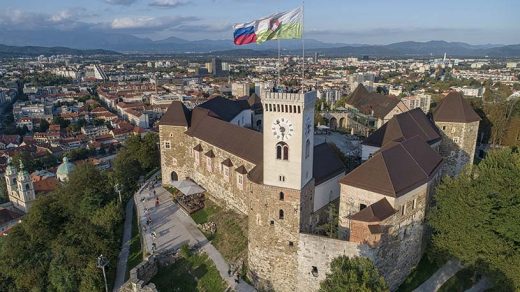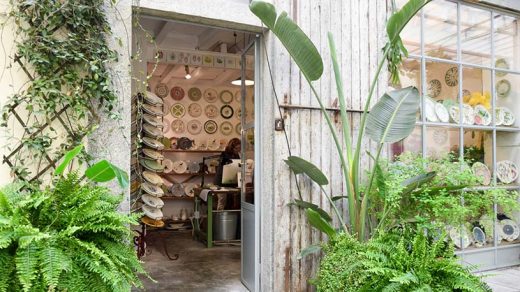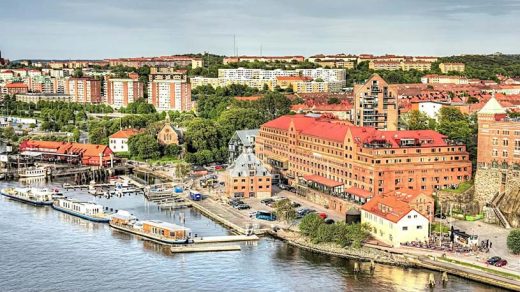Lisbon, my favorite city on the Atlantic Ocean. Lisbon colors your day. Literally. As a lover of bright colors, we almost melt, literally, through the beautifully painted walls (pink houses are the best!) and the bright blue sky that no Instagram filter can match. In bars like Portas do Sol, Café a Brasileira, or Electrico Banana café, simply sitting with the right drink is pure enjoyment. The sun in the spring is not too hot, but wonderfully pleasant. Bathed in a mixture of sea air, the scent of pastéis de Belém, and grilled sardines, there is nothing that can take away your vacation feeling.
It is a city full of charm and contrast. The city of the seven hills shines with mosaics, colored tiles, and winding alleys, and is immensely proud of historic neighborhoods like Alfama and Mouraria.
Lisbon is a city trip for those who love convenience: cheap, warm, cozy, ocean-surrounded, and nestled in delightful suburbs and lush greenery. This is a travel guide to the Portuguese capital, Lisbon.
- What to Do in Lisbon
- 30 Sights Worth Visiting
What to Do in Lisbon?
These are some of the best things to do in Lisbon. Discover the colorful tiles on the houses and the famous azulejos. In Belém, you must try the delicious pastéis de nata while admiring the impressive Torre de Belém, which stands guard over the river. But there is so much more to see in Lisbon.
As Fado music melancholically blends with the gentle sea breeze, you can walk through narrow streets to the modern Parque das Nações. Explore the rich history in Belém, where you’ll find the impressive Mosteiro dos Jerónimos and the Torre de Belém. Experience the futuristic flair and bustling city life. Climb the hill to the imposing Castelo de São Jorge and enjoy the breathtaking view over the red roofs and the sparkling Tagus River.
30 Sights and Fun Things to Do in Lisbon
Alfama
Sé Cathedral
The Sé Cathedral, also known as the Cathedral of Lisbon, is the oldest church in the city, built in the 12th century. This cathedral combines Romanesque, Gothic, and Baroque styles and has a fascinating interior with religious artworks. It also offers a beautiful view over the city from the bell tower.
Panteão Nacional
The Panteão Nacional, also known as the Church of Santa Engrácia, is a beautiful Baroque building that houses the tombs of some of Portugal’s most prominent figures. Construction of the pantheon began in the 17th century and was only completed in the 20th century. The interior is impressive, and the rooftop terrace offers a beautiful view over the city and the Tagus River.
Castelo de São Jorge
The Castelo de São Jorge is a historic castle that towers high above Lisbon and offers a panoramic view over the city. The castle dates back to the Middle Ages and has a rich history, with influences from Moorish and Christian occupation. Visitors can walk through the castle walls and explore the archaeological site.
Casa dos Bicos
The Casa dos Bicos is a striking Renaissance building with a unique, diamond-shaped façade, located in the historic center of Lisbon. The building now houses the José Saramago Foundation and a museum dedicated to the Nobel Prize-winning writer. The interior offers exhibitions about Saramago’s life and work, as well as cultural events.
Chiado
Convento do Carmo
The Convento do Carmo is an impressive Gothic church and convent, partly destroyed by the earthquake of 1755. The open-air ruins and Gothic arches provide a unique atmosphere, and it now houses the archaeological museum of Lisbon. Visitors can admire ancient artifacts and learn more about the city’s rich history.
Igreja do Carmo
The Igreja do Carmo is a Gothic church that was heavily damaged during the earthquake of 1755 and has since remained in a ruined state. The open-air interior and Gothic arches give a unique atmosphere to this historic site. Today, the church houses the Museu Arqueológico do Carmo, where you can admire archaeological finds.
Amoreiras
Aqueduct of Águas Livres
The Aqueduct of Águas Livres is an impressive 18th-century structure that provided Lisbon with water. The aqueduct is known for its high, stone arches that dominate the landscape. Visitors can walk along the top and enjoy views over the city.
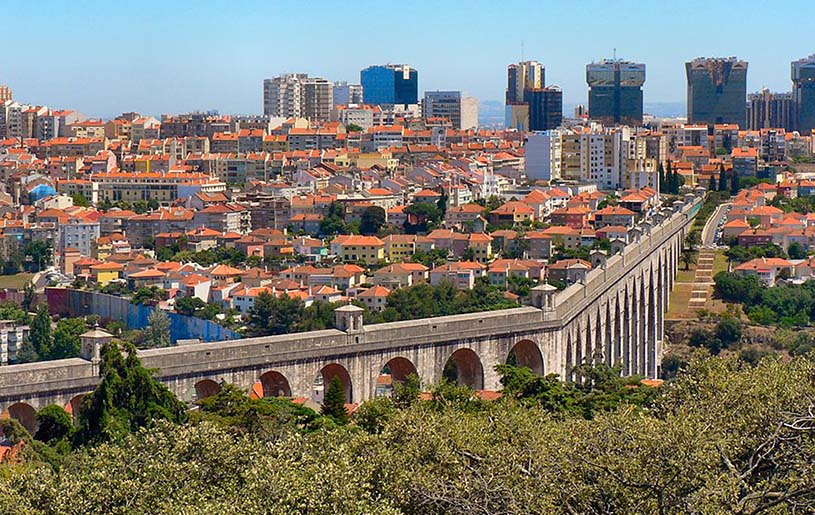
Alcântara
Ponte 25 de Abril
The Ponte 25 de Abril is a striking suspension bridge that connects Lisbon with Almada over the Tagus River. Often compared to the Golden Gate Bridge in San Francisco, this bridge is a major traffic artery. It offers an impressive view over the city and the river, especially at sunset.
Visit LX Factory
LX Factory in Lisbon is a creative and cultural hub located in a former industrial complex in the Alcântara district. Think art, design, fashion, and gastronomy. You’ll find many trendy shops, innovative workspaces, art galleries, and unique restaurants and cafes. Visitors are drawn by the eclectic atmosphere, rich cultural offerings, and the opportunity to discover a different side of Lisbon, away from the typical tourist spots.
Almada
Cristo Rei
The Cristo Rei statue, inspired by the famous Christ the Redeemer statue in Rio de Janeiro, overlooks the Tagus River. This 28-meter-high statue stands on an 82-meter pedestal, making it an impressive monument. From the top, you have a panoramic view of Lisbon and the surrounding areas.
Baixa
Rossio
Rossio is a lively square in the heart of Lisbon, officially known as Praça Dom Pedro IV. The square is surrounded by historic buildings, shops, and cozy cafes, and is a popular meeting place for both locals and tourists. The distinctive wavy mosaic pavement and the baroque fountain contribute to the charming atmosphere.
Elevador de Santa Justa
The Elevador de Santa Justa is an iconic wrought-iron elevator in the center of Lisbon, designed by a student of Gustave Eiffel. The elevator connects the lower Baixa district with the higher Bairro Alto and offers a beautiful view over the city. At the top, you’ll find a terrace where you can enjoy the panoramic view.
Praça do Comércio
Praça do Comércio is a large, elegant square on the banks of the Tagus River, also known as Terreiro do Paço. The square is surrounded by stately, yellow buildings and historic monuments, such as the triumphal arch Arco da Rua Augusta. It is a popular place for both tourists and locals to stroll and enjoy the river views.
São Bento
Palácio de São Bento
The Palácio de São Bento is the seat of the Portuguese parliament, housed in a former Benedictine monastery. This neoclassical building has an impressive façade and a richly decorated interior. It is possible to take guided tours and learn more about the political history of Portugal.
Sintra
Palácio da Pena
Palácio da Pena is a colorful and fairy-tale-like palace located in the hills of Sintra, a UNESCO World Heritage site. The palace combines various architectural styles, including Neo-Gothic, Neo-Manueline, and Moorish architecture. The surrounding gardens are also beautiful and offer walking paths and vistas over the landscape.
Estrela
Basílica da Estrela
The Basílica da Estrela is a beautiful basilica with an impressive dome and a richly decorated interior. This 18th-century church is one of the most striking religious buildings in Lisbon. The adjacent park, Jardim da Estrela, is a peaceful spot for a walk or a picnic.
Belém
Monastery of Jerónimos
The Mosteiro dos Jerónimos is a large, impressive monastery in Belém, built in the late Gothic Manueline style. This UNESCO World Heritage site served as a residence for the Order of St. Jerome and played an important role in Portuguese exploration. The beautiful cloisters and richly decorated interior are worth a visit.
Belém Tower
The Torre de Belém is an iconic tower on the banks of the Tagus, built in the 16th century to defend the city. This UNESCO World Heritage site is a beautiful example of Manueline architecture. The tower offers a fascinating insight into the history of Portuguese exploration.
Monument to the Discoveries
The Monument to the Discoveries (Padrão dos Descobrimentos) in Belém honors the Portuguese explorers of the 15th and 16th centuries. The monument is shaped like a ship with sculptures of important historical figures, including Henry the Navigator. Visitors can climb to the top for a panoramic view of the Tagus River and the city.
Avenidas Novas
Campo Pequeno
Campo Pequeno is a historic bullring, built in the late 19th century in Moorish style. Today, the building is used for various events such as concerts, exhibitions, and sports competitions. The arena also houses a shopping center and several restaurants.
Parque Eduardo VII
Parque Eduardo VII is a large city park that stretches from Praça Marquês de Pombal to the north. The park offers beautiful views over the city and the Tagus River, especially from the elevated viewpoint. There are also well-maintained gardens, ponds, and a greenhouse with tropical plants.
Calouste Gulbenkian Museum
The Calouste Gulbenkian Museum houses a rich collection of artworks, from antiquities to modern art, collected by the Armenian-Portuguese magnate Calouste Gulbenkian. The museum is divided into two sections: the classical collection and the modern collection, featuring works by artists such as Rembrandt, Monet, and René Lalique. The surrounding gardens are a peaceful place to walk and enjoy nature.
Parque das Nações
Oceanarium
The Oceanário de Lisboa is one of the largest aquariums in the world, located in the modern district of Parque das Nações. It offers an impressive collection of marine life, with habitats mimicking the ocean ecosystems of the world. Highlights include the giant central tank and the various thematic zones.
Vasco da Gama Tower
The Vasco da Gama Tower is a modern tower located on the banks of the Tagus River in the Parque das Nações district. Built for Expo ’98, the tower stands at 145 meters high and offers an observation deck with a spectacular view of the city and the river. The shape of the tower is inspired by the sail of a caravel, a traditional Portuguese ship.
Vasco da Gama Bridge
The Vasco da Gama Bridge is an impressive bridge over the Tagus River and, at 17.2 kilometers, is the longest bridge in Europe. The bridge connects Lisbon to the eastern suburbs and was opened for the World Expo in 1998. It is an impressive feat of modern engineering and architecture.
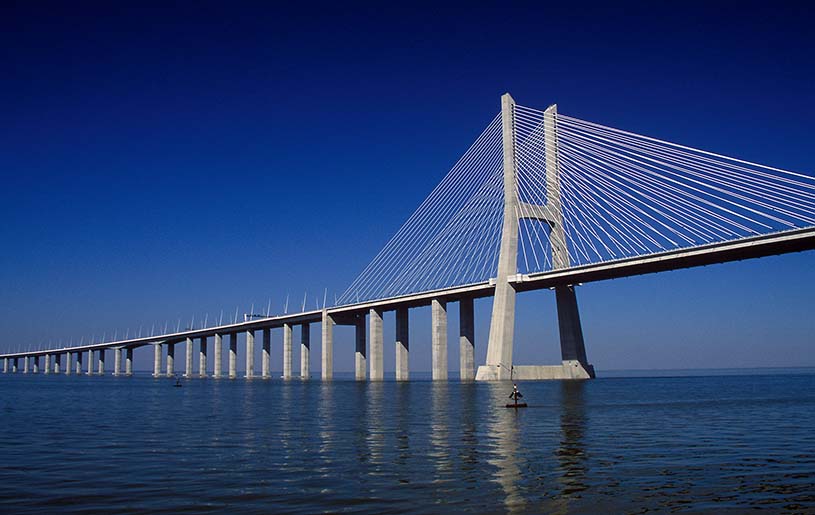
Gare do Oriente
Gare do Oriente is a modern, architecturally striking train station in the Parque das Nações district, designed by Santiago Calatrava. The station serves as a major transportation hub, with connections for trains, buses, and the metro. Its glass and steel structure make it an impressive example of modern architecture.
Parque das Nações
Parque das Nações is a modern district on the eastern side of Lisbon, developed for Expo ’98. This area offers a mix of cultural, recreational, and commercial attractions, including the Oceanário, the cable car, and the Vasco da Gama shopping center. The futuristic architecture and beautiful riverside promenades make it a popular spot for both tourists and locals.
Cable Car
The cable car in Parque das Nações offers panoramic views over the Tagus River and the modern part of Lisbon. The approximately one-kilometer ride is a relaxing way to explore the area from above. It provides a unique perspective on some of the major attractions, such as the Oceanário and the Vasco da Gama Tower.
Fun Throughout the City
Taking the Tram, Just Because!
Taking tram 28 is an icon of the city. It takes you through narrow, winding streets and past major landmarks of Lisbon. The characteristic yellow trams offer a glimpse of the locals’ daily life and are the perfect way to explore the city when you’re tired of walking up and down. It’s a must-do for every visitor. And if tram 28 is too crowded, just hop on any other tram and let fate guide you.
Tasting Cherry Liqueur
Ginjinha, or simply Ginja, is a popular Portuguese cherry liqueur that is especially popular in the downtown area of Lisbon. Traditionally served in small glasses, often with a cherry at the bottom, it’s a beloved treat for both locals and tourists. You’ll find various stalls to sip a little on the street, and I highly recommend you try it. At A Ginjinha Espinheira, you’ll taste the best!
Visiting a Fado House
Visiting a fado house in Lisbon is truly delightful. You can feel the emotion in every note, so pure and intense is that music. Add some delicious food to it, and you’re guaranteed a top-notch evening. It’s really something you shouldn’t miss when you’re in the city. For a true fado experience in Lisbon, you must go to Clube de Fado in Alfama, Rua de São João da Praça 86. Another recommendation is Tasca do Chico in Bairro Alto, Rua do Diário de Notícias 39, where the atmosphere is always cozy and intimate. Also, A Baiuca, Rua de São Miguel 20, in Alfama offers great performances in a snug setting. Don’t forget to make reservations in advance, as these places are popular!
As you explore the vibrant streets of Lisbon, whether it’s by hopping on a tram, savoring cherry liqueur, or immersing yourself in the soulful melodies of fado, you’ll find that the city has a unique charm that captivates every visitor. From its historic landmarks to its modern attractions, Lisbon offers a delightful blend of tradition and innovation. So, whether you’re strolling through its winding alleys or gazing out at the Tagus River, let the spirit of Lisbon envelop you, leaving you with memories to cherish long after you’ve left this enchanting city.
